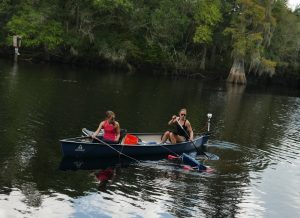
It’s strange to think that people living in Southeast Asia and the Amazon rainforest might know more about a lab based at the University of South Florida than Tampa Bay residents, but that’s what happened with the Watershed Sustainability Lab (WSL).
“Most of the research we’ve done is international but we’re working on more local projects now,” said Mauricio E. Arias, leader of a group of engineers and scientists based in USF’s Department of Civil and Environmental Engineering. “We’re a group of engineers and scientists working together to solve water management problems by creating links between the hydrological cycle, ecosystems, and society.”
The lab’s international work includes looking for solutions to mitigate man-made impacts on the Mekong River, which runs more than 3,000 miles through Vietnam and Cambodia, and the Tapajos River, one of the largest sub-basins in the Amazon. In both locations, hydroelectric power is an important energy resource, but it also impacts aquatic ecosystems.
“We’re looking at the specific effects of dams on aquatic ecosystems, which are typically negative, and then there are other issues involved like overfishing, deforestation, pollution and climate change,” he said.
Ongoing research focuses on ways to operate the dams that minimize their impact on ecosystems and fisheries. “It’s not just the dams interrupting water flow, it’s how they’re managed, when they’re running and how much water is released. We’re providing the science to encourage optimization of ecosystems while operating the dams and generating hydropower.”

While research in Southeast Asia and Brazil has been underway for more than a decade, new research closer to home promises to have significant impacts for Tampa Bay and beyond.
Ground-breaking research on how to make desalination plants more energy efficient is underway at Tampa Bay Water’s facility in Apollo Beach, where energy costs have limited its production capacity except during times of extreme drought. “We’re using Tampa Bay as a case study, but we hope it can be replicated in other places,” Arias said.
Working with the city of Tampa, WSL is unraveling the most effective way to use baffle boxes that capture sediments and the nutrients they carry, particularly as sea-level rise has left the underground boxes underwater in some places, limiting their ability to collect sediment effectively. The multi-phase effort includes quantifying pollutant loads into baffle boxes, continual monitoring of loads in some boxes, and developing a model for baffle box performance.
Another problem identified early on: much of what the baffle boxes collected was plastic litter and yard waste, which they were not designed to capture. That means there is less room in the box for sediments before they need to be vacuumed out. “It’s easy to say but hard to prevent,” Arias said. “It requires a community effort to explain to people that trash and yard waste don’t belong in the stormwater system.”
Also in Tampa, team members collected and tracked microplastics at three locations in the Hillsborough River over an 18-month period to determine how land use and rainfall impact quantities of microplastics. “Coastal urban rivers are focal points for intervention to reduce plastics from entering marine systems. The assumption is that the more water, the more trash but that’s not always true,” Arias said. A final report, including the sources of microplastics found, is pending review.
Newest projects look at coral reefs, nutrients in the Everglades watershed

WSL’s newest Florida project is using a U.S. Environmental Protection Agency grant to tackle algae blooms in Lake Okeechobee as well as the estuaries where it drains on the east and west coasts. “We’re looking at the best technologies to use in the entire watershed, which runs all the way up to Disney World,” Arias said. “It’s complicated and there won’t be a silver bullet.”
Even with multiple years of research, it’s hard to attribute the problem to one source of nutrients over another, he adds. “Certainly agriculture plays a role, as do nutrients from fertilizers used on lawns but so do wastewater and animal feces. The goal has to be to reduce the overall impact on the ecosystem.”
Further south, after two years of monitoring transplanted coral reefs in the Florida Keys using sophisticated chemical analysis that measures metabolic changes in coral, WSL researchers are working on a proof of concept that would expand the testing to more reefs even before they show signs of damage.
“The goal here is to detect disease at an early stage by monitoring their vital signals,” Arias said. “It’s important to monitor because otherwise we might not know they’re sick until they’re really, really sick.”
Learn more about the Watershed Sustainability Lab at https://www.watershedsustainability.org/.
